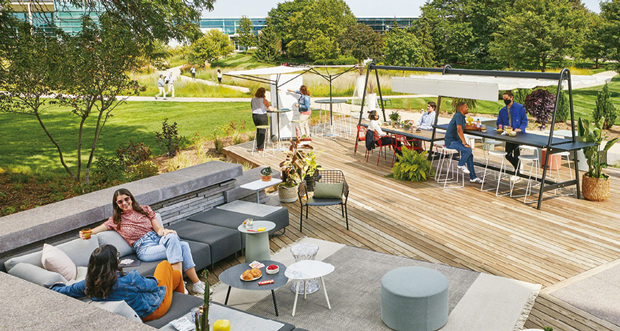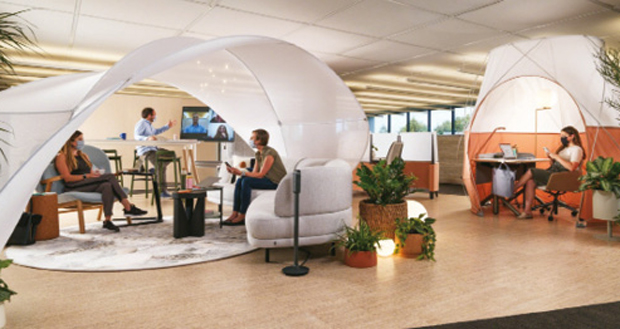A Steelcase report has found that despite the threat of the pandemic receding, over half of staff still prefer working from home. Rocio Diez, Comms Manager EMEA at Steelcase, looks at how good workplace design can help draw them back
Over two years ago the world of work shifted almost overnight. The home became the office for many. While it was a novelty at first, it quickly became deeply ingrained in the national psyche. So much so that while most aspects of a return to normality was celebrated, heading back to the office was not embraced by many with open arms. In fact, our Global report, The New Era of Hybrid Work, highlighted that six in ten (58 per cent) workers now prefer to work from home to the office.
With expectations shifting, working in the office needs to be an enjoyable prospect to tempt people back into the workplace. In an effort to curb the great resignation, organisations need to redesign their office space to become an environment that is suited to the hybrid working style craved by workers in this post-pandemic era. So, what is it staff want most from their hybrid working space?
WHY DO EMPLOYEES WANT TO RETURN?
The first thing to address is why are organisations going through all this effort? There are many selling points to coming back to the office for both the organisation and the employees. Culture is a very important part of returning to the office. Globally 30 per cent of employees feel more connected to culture when in the office. Steelcase’s study found that enjoying working in the office has the biggest impact on engagement, connection to culture and productivity. Shaping spaces and environments that people want to work in can positively impact all these factors. Twent eight per cent of people also shared that (only second to tenure) enjoying working from the office contributed to staying in the organisation. Around the world, people enjoy being a part of the environment in their workplace and space and design contribute to this satisfaction.
WHAT EMPLOYEES WANT
One of the most appealing attributes of home working for two-thirds (65 per cent) of UK employees today is to have a dedicated space for work. However, the norm is anything but. In most offices, the majority (59 per cent) have desks in open areas, offering minimal privacy. Giving employees their own space in the office is therefore an important part of creating an appealing environment.
One thing workers obviously struggled with at home is the ability to work alongside and collaborate with others. Data showed that 64 per cent of workers value hybrid collaboration spaces. Yet, for many, traditional hybrid collaboration spaces come with too many inconveniences; not least of which is the inadequacies of the technology. However, the biggest issue with such spaces sits more in the design. Nearly half of people think the spaces are too small to work collaboratively and can be noisy. These issues need to be addressed.
THE MANAGEMENT EFFORTS
For management teams, the pandemic has been a challenging time to be running a business. From financial worries to the constant need to adapt working practices, keeping on top of how to keep employees engaged and happy has vexed many. While it has been a hurdle, organisations can utilise it as a catalyst for change. The hardest battle to fight is disparity, but it is worth the effort. Management needs to make sure they are designing the best possible spaces to lower disparity levels. Listening to employees needs from their environment is the best way to make sure all staff remain engaged, no matter their location.
Engagement is often linked with enjoyment. Unfortunately, there is a clear difference between the enjoyment of management and employees when in the office. Seventy nine per cent of leaders say they prefer working from the office, while only 56 per cent of employees say the same. The reason for this divide could be determined by the work being completed and space on offer to do so. As an organisation, giving private workspaces and areas to your employees will help balance this disparity and create an office where staff are comfortable, and can work optimally and collaboratively.
WHAT’S NEXT?
People are social animals and work is inherently a social undertaking. Keeping people tethered to a computer screen is not the answer, nor is keeping them tethered to a workplace that doesn’t help them do their best work.
It’s time to put the needs of people in the forefront and design policies and places that help people and organisations thrive. Communities are living systems, whether they are places people live or groups connected by a shared purpose. Neighbourhoods at work are a base for people, teams or departments. They include a variety of interconnected spaces that support a mixture of uses, feel organic and flow naturally from one to another.
Earning the commute of your workers has never been more important and this post pandemic working style is something for all members of a company to get used to. However, hopefully this article goes some way to help outline what can be changed and improved in an office to create a successful hybrid working environment.






